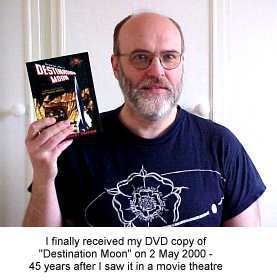Donald Savage/Gretchen Cook-Anderson
Headquarters, Washington
(Phone: 202/358-1727/0836)
| Dec. 22, 2004 |
RELEASE: 04-407
|
NASA Selects Investigations for Lunar Reconnaissance Orbiter
NASA has selected six proposals to provide instrumentation and associated exploration/science measurement investigations for the Lunar Reconnaissance Orbiter (LRO), the first spacecraft to be built as part of the Vision for Space Exploration.
The LRO mission is scheduled to launch in the fall of 2008 as part of NASA's Robotic Lunar Exploration Program. The mission will deliver a powerful orbiter to the vicinity of the moon to obtain measurements necessary to characterize future robotic and human landing sites. It also will identify potential lunar resources and document aspects of the lunar radiation environment relevant to human biological responses.
Proposals were submitted to NASA in response to an Announcement of Opportunity released in June 2004. Instrumentation provided by these selected measurement investigations will be the payload of the mission scheduled to launch in October 2008.
"The payload we have selected for LRO builds on our collective experience in remote sensing of the Earth and Mars," said NASA's Deputy Associate Administrator for the Science Mission Directorate, Dr. Ghassem Asrar. "The measurements obtained by these instruments will characterize in unprecedented ways the moon's surface and environment for return of humans in the next decade," he added.
"LRO will deliver measurements that will be critical to the key decisions we must make before the end of this decade," said NASA's Associate Administrator for the Exploration Systems Mission Directorate, Craig Steidle. "We are extremely excited by this innovative payload, and we are confident it will fulfill our expectations and support the Vision for Space Exploration," Steidle added.
"The instruments selected for LRO represent an ideal example of a dual use payload in which exploration relevance and potential scientific impact are jointly maximized," NASA's Chief Scientist, Dr. Jim Garvin said. "I am confident LRO will discover a 'new moon' for us, and in doing so shape our human exploration agenda for our nearest planetary neighbor for decades to come," he said.
The selected proposals will conduct Phase A/B studies to focus on how proposed hardware can best be accommodated, completed, and delivered on a schedule consistent with the mission timeline. An Instrument Preliminary Design Review and Confirmation for Phase C Review will be held at the completion of Phase B.
Selected investigations and principal investigators:
"Lunar Orbiter Laser Altimeter (LOLA) Measurement Investigation" - principal investigator Dr. David E. Smith, NASA Goddard Space Flight Center (GSFC), Greenbelt, Md. LOLA will determine the global topography of the lunar surface at high resolution, measure landing site slopes and search for polar ices in shadowed regions.
"Lunar Reconnaissance Orbiter Camera" (LROC) - principal investigator Dr. Mark Robinson, Northwestern University, Evanston, Ill. LROC will acquire targeted images of the lunar surface capable of resolving small-scale features that could be landing site hazards, as well as wide-angle images at multiple wavelengths of the lunar poles to document changing illumination conditions and potential resources.
"Lunar Exploration Neutron Detector" (LEND) - principal investigator Dr. Igor Mitrofanov, Institute for Space Research, and Federal Space Agency, Moscow. LEND will map the flux of neutrons from the lunar surface to search for evidence of water ice and provide measurements of the space radiation environment which can be useful for future human exploration.
"Diviner Lunar Radiometer Experiment" - principal investigator Prof. David Paige, UCLA, Los Angeles. Diviner will map the temperature of the entire lunar surface at 300 meter horizontal scales to identify cold-traps and potential ice deposits.
"Lyman-Alpha Mapping Project" (LAMP) - principal investigator Dr. Alan Stern, Southwest Research Institute, Boulder, Colo. LAMP will observe the entire lunar surface in the far ultraviolet. LAMP will search for surface ices and frosts in the polar regions and provide images of permanently shadowed regions illuminated only by starlight.
"Cosmic Ray Telescope for the Effects of Radiation" (CRaTER) - principal investigator Prof. Harlan Spence, Boston University, Mass. CRaTER will investigate the effect of galactic cosmic rays on tissue-equivalent plastics as a constraint on models of biological response to background space radiation.
The LRO project is managed by GSFC. Goddard will acquire the launch system and spacecraft, provide payload accommodations, mission systems engineering, assurance, and management. For information about NASA and agency programs on the Internet, visit:
http://www.nasa.gov












